Editor's update for April 9: The April 15 total lunar eclipse is the first in a four-eclipse cycle called a tetrad. To see our latest story on the tetrad, read: Four Blood Moons: Total Lunar Eclipse Series Not a Sign of Apocalypse
Stargazers and lunar fans in the Western Hemisphere will have ringside seats for a total eclipse of the moon during the overnight hours of April 14 and 15.
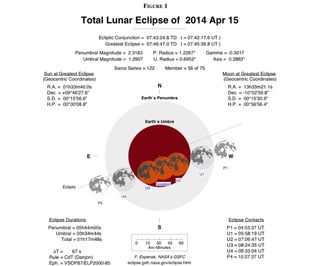
This spectacle of celestial shadows will be the first of two total lunar eclipses in 2014 that will be visible from North America. Unlike an eclipse of the sun, an eclipse of the moon presents no hazards to the viewer. No precautions to protect the eyes are needed.
For the Western Hemisphere, the eclipse will "officially" begin on April 15 at 12:53 a.m. EDT (0435 GMT), when the moon begins to enter Earth's outer, or penumbral shadow. But even in clear weather, skywatchers will not notice any changes in the moon's appearance until about 50 minutes later, when a slight "smudge" or shading starts becoming evident on the left portion of the moon’s disk. [Total Lunar Eclipse of April 15 Explained (Video)]
The first definitive change in the moon's appearance will come on its upper left edge. At 1:58 a.m. EDT (0558 GMT), the partial phase of the eclipse will begin as the Earth’s dark shadow, called the umbra, starts to slowly creep over the face of the full moon.

At 3:06 a.m. EDT, the eclipse will reach totality, but sunlight bent by our atmosphere around the curvature of the Earth should produce a coppery glow on the moon. At this time, the moon, if viewed with binoculars or a small telescope, will present the illusion of seemingly glowing from within by its own light.
At 3:46 a.m. EDT, the sun, Earth and moon will be almost exactly in line and the light of the moon will appear at its dimmest. "Totality" ends at 4:24 a.m. EDT, and the moon will completely emerge from the umbra at 5:33 a.m. About 20 minutes later, the last vestige of the fainter penumbral shadow will disappear from the moon’s upper right edge, and the body will return to its normal brilliance.
Get the Space.com Newsletter
Breaking space news, the latest updates on rocket launches, skywatching events and more!
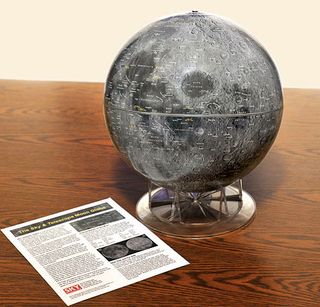

Regions of visibility
The entire 78 minutes of total eclipse will be visible from all of North and South America. Totality will also be visible in its entirety from New Zealand and Hawaii. [Amazing Lunar Eclipse Photos: Full Moon of April 2013]
In all, an estimated 922 million people will have an opportunity to enjoy this best part of the lunar show from start to finish. In other parts of the world, only the partial stages of the eclipse will be visible, moonrise or moonset will intervene during the total phase or the eclipse will occur during daytime and the moon is not above the local horizon.
Portions of westernmost Africa can catch the opening stages of the eclipse before the moon sets below their horizon during the morning hours of April 15. A slice of eastern Asia and all of the Land Down Under except Western Australia, meanwhile, can catch the closing stages just after moonrise on the evening of April 15.
Generally speaking, more than 1 billion people will be able to view at least part of this eclipse. But because Europe and most of Asia will be turned away from the moon and will be in daylight during the eclipse, the majority of the world’s population will miss out on this shady celestial drama.
For any one location, total lunar eclipses occur at an average frequency of four or five times per decade. The last total eclipse of the moon occurred on Dec. 10, 2011. The next will occur later this year on Oct. 8. That upcoming one will also be visible from North America, though along the East Coast the moon will set during the total phase.
Interestingly, this month's total eclipse is the first of four consecutive total eclipses occurring at approximately six-month intervals — a phenomenon called a tetrad. In addition to the two totalities occurring this year, there will be two more in 2015, on April 4 and Sept. 28.
"The most unique thing about the 2014-2015 tetrad is that all of them are visible for all or parts of the USA," said longtime NASA eclipse expert Fred Espenak.
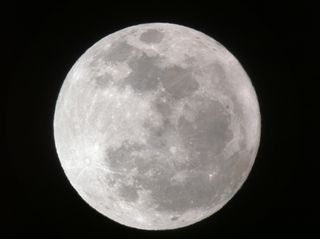
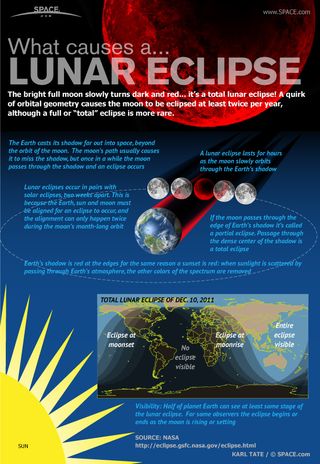
Only the shadow knows the moon's color
Although astronomers do not expect to gain new astronomical insights from the eclipse, lunar eclipses vividly reflect the overall state of Earth's atmosphere.
Under normal weather and atmospheric conditions, as the moon slides into the shadow of the Earth, the satellite's normal yellow-white color changes into a dull coppery-red at the height of the eclipse. Since the sun’s rays are bent by Earth’s atmosphere so that some still reach the moon, the moon is still visible during a total lunar eclipse.
However, if a major volcanic eruption has taken place in the weeks or months prior to a total lunar eclipse, a cloud of ash and dust floating high above the Earth could make the moon appear darker than usual during totality; parts of the moon might even become black and invisible.
Or the moon might wear its normal eclipse cloak of a deep red or a coppery hue or take on still other colors (orange, chocolate-brown or gray). Color possibilities are unpredictable since it is impossible to tell exactly how much light Earth's atmosphere will refract as its shadow creeps across the moon. Cloud cover and other atmospheric conditions may also affect the visibility and coloration of the moon.
In short: We’ll all just have to wait for eclipse night and see what actually happens.
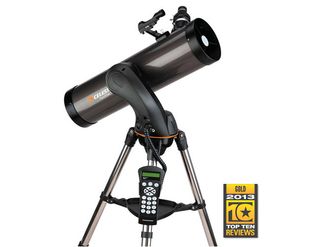
Rare pairing off with a bright star
During the eclipse, no doubt many will take note of a conspicuous star situated just to the right and a bit below the moon. This will be Spica, the brightest star in the constellation Virgo and one of the 21 brightest stars in the sky.
During totality, the contrast in color between the eerie red ball of the moon and this bluish star will be striking. A close approach of the eclipsed moon and a particular star is a rather rare event. It last happened with Spica on the night of April 12 and 13, 1968. The next time a bright star will approach as closely to a totally eclipsed moon will be on Feb. 25, 2510, when the star in question will be Regulus in the constellation Leo.
Space.com will provide tips on how to judge the color and brightness of the upcoming eclipse in an April 11 night sky observing guide, and we'll also publish an Eclipse Observers Guide on April 13. So stay tuned!
Editor's Note: If you snap an amazing picture of the Aprl 15 total lunar eclipse or any other night sky view that you'd like to share for a possible story or image gallery, send photos, comments and your name and location to managing editor Tariq Malik at spacephotos@space.com.
Joe Rao serves as an instructor and guest lecturer at New York's Hayden Planetarium. He writes about astronomy for Natural History magazine, the Farmer's Almanac and other publications, and he is also an on-camera meteorologist for News 12 Westchester, N.Y. Follow us @Spacedotcom, Facebook or Google+. Originally published on Space.com.
Join our Space Forums to keep talking space on the latest missions, night sky and more! And if you have a news tip, correction or comment, let us know at: community@space.com.

Joe Rao is Space.com's skywatching columnist, as well as a veteran meteorologist and eclipse chaser who also serves as an instructor and guest lecturer at New York's Hayden Planetarium. He writes about astronomy for Natural History magazine, the Farmers' Almanac and other publications. Joe is an 8-time Emmy-nominated meteorologist who served the Putnam Valley region of New York for over 21 years. You can find him on Twitter and YouTube tracking lunar and solar eclipses, meteor showers and more. To find out Joe's latest project, visit him on Twitter.
